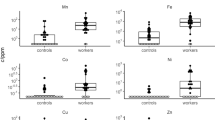Abstract
Due to the exposure to alumina in the air, workers in the primary aluminium industry are expected to exhibit a higher aluminium exposure than the general population. The additional daily intake will be less than 20 mg. The determination of aluminium in blood plasma of electrolysis-workers by flameless atomic absorption spectrometry revealed levels before shift in the range of 20–30 μg/L compared to levels of less than 3 μg/L in a non-occupationally exposed group. These levels refer to work in old plants with unhooded pots. The plasma levels can rise up to 60 μg/L during the shift. A similar rapid change of the levels during work is seen in the urine values. Due to the delay in excretion the maximal values in the range of 5 μg/h are found four hours after cessation of work. It seems therefore that only preshift samples give a reliable measure of the body burden. Compared to the much higher levels in dialysis patients the observed values in aluminium workers are not considered to be of relevance to health.
Similar content being viewed by others
References
Hartung, M., Schaller, K.-H., Kentner, M., Manke, H.-G., Weltle, D. and Grimm, H.-G. 1984. Untersuchungen zur Aluminium-Belastung bei der Herstellung von Bronzepigmenten. Bericht über die 24.Jahrestagung der Deutschen Gesellschaft für Arbeitsmedizin e.V., Mainz, 2. bis.5, Mai 1984, S. 289–292.
Harwerth, A., Kufner, G. and Helbing, F. 1987. Untersuchung zur Belastung und Beanspruchung von Aluminiumschleifem durch Aluminiumstaub.Arbeitsmedizin, Sozialmedizin Präventivmedizin,22, 2–5.
Knutti, R. and Zimmerli, B. 1985. Analysis of daily rations from Swiss canteens and restaurants. 111. Lead, cadmium, mercury, nickel and aluminium.Mitt. Gebiete Lebensm. Hyg.,76, 206–232.
Mussi, I., Calzaferri, G., Buratti, M. and Alessio, L. 1984. Behaviour of plasma and urinary aluminium levels in occupationally exposed subjects.Int. Arch. Occupat. Environ. Health,54, 155–161.
Rickenbacher, U. 1984. Gastrointestinal absorption and toxic effects of aluminium compounds in test animals and exposed persons. Thesis No. 7480, Swiss Fed. Inst. Technol., Zurich.
Sjögren, B., Lundberg, I. and Lidums, V. 1983. Aluminium in the blood and urine of industrially exposed workers.Brit. J. Indust. Med.,40, 301–304.
Szczekocki, W. and Chmielewski, J. 1977. Indices of the occupational exposure to aluminium oxide dusts.Pol. Typ. Lek.,20, 37–42.
Valentin, H. Preusser, P. and Schaller, K.H. 1976. Die Analyse vom Aluminium im Serum und Urin zur Ueberwachung exponierter Personen.Int. Arch. Occupat. Environ. Health,38, 1–17.
Waldron-Edward, D., Chan, P. and Skoryna, S.C. 1971. Increased prothrombin time and metabolic changes with high serum aluminum levels following long-term exposure to Bayer-process alumina.Can. Med. Assoc. J.,105, 1297–1299.
Author information
Authors and Affiliations
Rights and permissions
About this article
Cite this article
Schlatter, C., Steinegger, A., Rickenbacher, U. et al. Aluminium levels in the blood plasma of persons working in the aluminium industry. Environ Geochem Health 12, 59–64 (1990). https://doi.org/10.1007/BF01734049
Issue Date:
DOI: https://doi.org/10.1007/BF01734049




